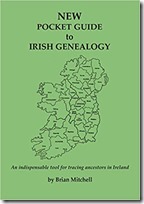 Title: New Pocket Guide to Irish Genealogy
Title: New Pocket Guide to Irish Genealogy
Author: Brian Mitchell
Format: Paperback
Published: 2020
My Rating: ![]()
![]()
![]()
![]()
This post contains affiliate links.
The New Pocket Guide to Irish Genealogy is an updated version of the Pocket Guide to Irish Genealogy, which was first published in 1991 (and revised in 2002 and 2008). This new version includes links to records and information online, as well as a discussion on the various types of DNA testing that can be used to seek out Irish roots.
Author Brian Mitchell starts the book with a short section on getting started, which includes a brief overview of Irish history. The bulk of the book covers various record types that are used in researching Irish ancestors. The first batch of records are Mitchell’s core seven: civil registrations, church records, gravestone inscriptions, wills, censuses, Griffith’s Valuation, and tithe books. The second batch covers additional record types to push Irish research to the next level and includes: newspapers, school records, plantation and settlement records, workhouse records, estate records (i.e., leases, etc.), and more. For each record type, Mitchell describes the record and provides insight on how to use the record to advance your research. The background he provides is extremely helpful, as it’s important to understand why and how records were created so they can be interpreted correctly.
I found the discussion of Griffith’s Valuation to be one of the best I’ve read, particularly its history and how best to use the information. The resources provided for gravestones were all new to me and I look forward to digging into them further. I also appreciated the wonderful details regarding school records and estate records. Really, I took away at least one tidbit for all the records discussed in this book.
The final part of the book includes discussions on: Ireland’s administrative divisions, surnames, passenger lists, DNA, and Scots-Irish sources. A three-step research guide and two case studies round out this final part.
While I think this is a good reference for Irish genealogy, there are a few things that kept me from giving it a higher rating.
First, the organization of the book was a little disjointed for me. I felt like the discussions of passenger lists and Scots-Irish sources could have been part of the second batch of record types. I also felt that the chapter on the administrative divisions should have been included in the getting started section. That said, if you’re unfamiliar with the administrative divisions of Ireland, I would suggest reading pages 79 to 83, before reading about the records, as it will help you understand the terminology used in the discussions of the records.
Additionally, while Internet resources for record collections both on-site and digitized were mentioned, noticeably missing was FamilySearch. For example, for school records, there is only mention of The National Archives in Dublin and the Public Record Office of Northern Ireland. A search of the FamilySearch catalog turned up school registers for three of the places my Irish ancestors hail from (and I could view them online from home). In fact, many of the record types presented in this book can be found in digital form through FamilySearch, or at least on film available through the Family History Library.
Overall, the book is a helpful resource for those who are searching for their Irish roots. The details provided for the various records types is extremely useful and there are certainly some points mentioned in this book that I’ve not seen elsewhere.
Disclaimer: I was offered a copy of this book in exchange for a review. This in no way altered my opinion and I have provided a fair review as if I had purchased the book myself.

